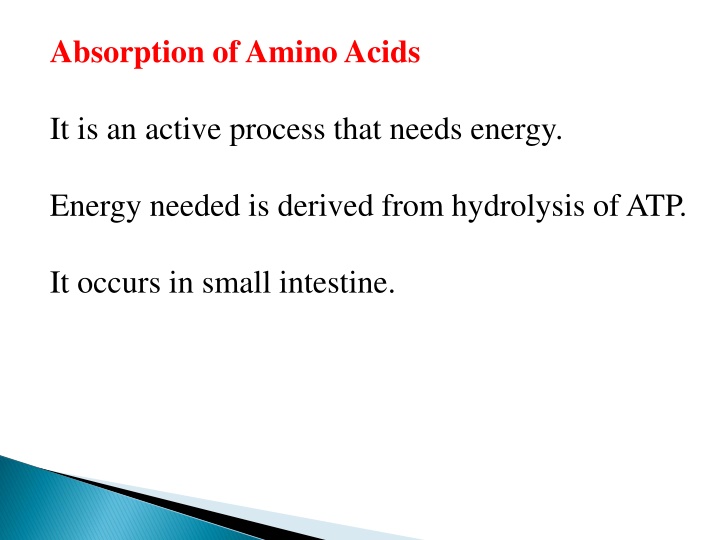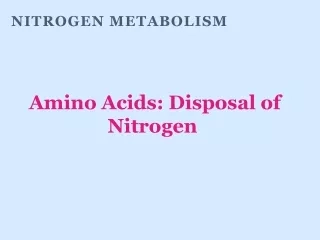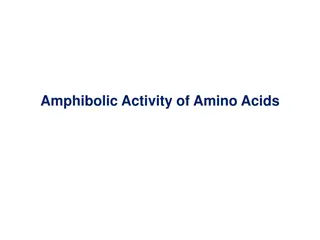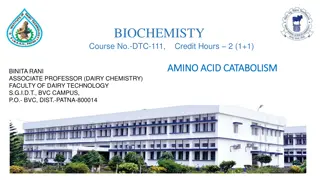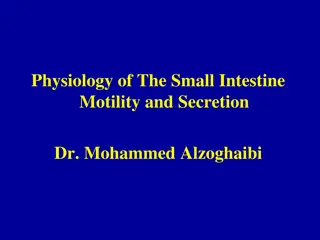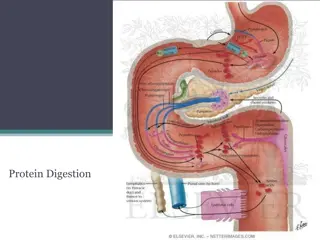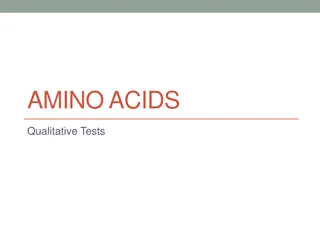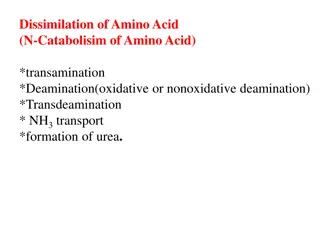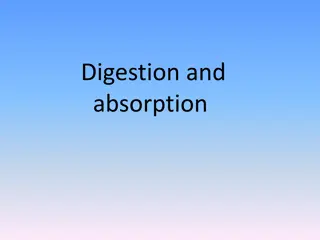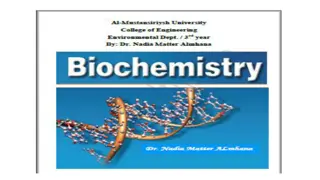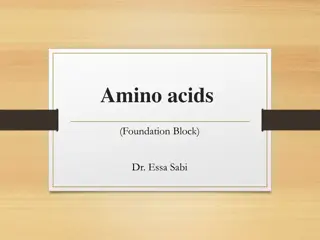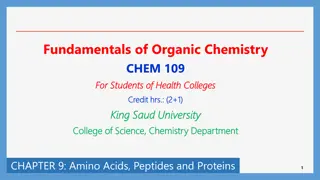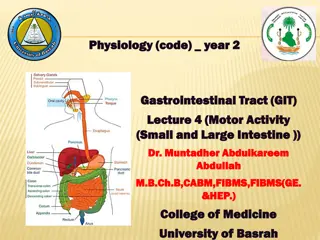Amino Acid Absorption Mechanisms in Small Intestine
Amino acid absorption in the small intestine is an active process requiring energy derived from ATP hydrolysis. It involves two main mechanisms: carrier proteins transport system and glutathione transport system. The carrier proteins transport system uses ATP energy for absorption, while glutathione transport system utilizes glutathione to transfer amino acids into intestinal mucosa cells. Defects in these systems can lead to disorders like cystinuria and affect protein absorption. Clinical conditions like oxoprolinuria and protein-losing enteropathy are associated with abnormalities in amino acid absorption.
Download Presentation

Please find below an Image/Link to download the presentation.
The content on the website is provided AS IS for your information and personal use only. It may not be sold, licensed, or shared on other websites without obtaining consent from the author.If you encounter any issues during the download, it is possible that the publisher has removed the file from their server.
You are allowed to download the files provided on this website for personal or commercial use, subject to the condition that they are used lawfully. All files are the property of their respective owners.
The content on the website is provided AS IS for your information and personal use only. It may not be sold, licensed, or shared on other websites without obtaining consent from the author.
E N D
Presentation Transcript
Absorption of Amino Acids It is an active process that needs energy. Energy needed is derived from hydrolysis of ATP. It occurs in small intestine.
Mechanisms of amino acids absorption There are two mechanisms for amino acids absorption. 1-Carrier proteins transport system 2-Glutathione transport system (g-Glutamyl cycle)
Carrier proteins transport system It is the main system for amino acid absorption. It is an active process that needs energy derived from ATP. Absorption of one amino acid molecule needs one ATP molecule. There are 7 carrier proteins, one for each group of amino acids. Each carrier protein has to sites one for amino acid and one for Na+. The absorbed amino acid passes to the portal circulation, while Na+ is extruded out of the cell in exchange with K+ by sodium pump.
Glutathione transport system (-Glutamyl cycle) -Glutathione is used to transport amino acids from intestinal lumen to cytosol of intestinal mucosa cells. -It is an active process that needs energy derived from ATP. -Absorption of one amino acid molecule needs 3 ATP molecules. -Glutathione reacts with amino acid in the presence of - glutamyl transpeptidase to form -glutamyl amino acid.
--glutamyl amino acid releases amino acid in the cytosol of intestinal mucosa cells with formation of 5-oxoproline that is used for regeneration of glutathione to begin another turn of the cycle.
Clinical Clinical Applications Applications Oxoprolinuria: The deficiency of the enzyme accumulation of 5-oxoproline in blood and hence excreted in urine. It is associated with mental retardation. 5-oxoprolinase leads to The allergy to certain food proteins (milk, fish) is believed to result from absorption of partially digested proteins.
Defects in the intestinal amino acid transport systems are seen in inborn errors of metabolism such as cystinuria . Partial carcinoma of pancreas and cystic fibrosis may affect the digestion and absorption of proteins. gastrectomy, pancreatitis, Protein excessive loss of proteins through the gastrointestinal tract. Protein losing losing enteropathy enteropathy: : There is an
Amino Acid Pool The amount of free amino acids distributed throughout the body is called amino acid pool. Plasma level for most amino acids varies widely throughout the day. It ranges between 4 5 mg/dl. Following a protein containing meal, the amino acid levels rise to (45 - 100 mg / dl).
Tissue Amino acids The amino acids are transported into tissues actively. Pyridoxal-P (B6-P) is one of the requirement for this active transport. Tissue uptake is also favoured by hormones: Insulin, growth hormone and testosterone favour the uptake of amino acids by tissues (anabolic hormones). Estradiol stimulates selectively their uptake by uterus. Epinephrine and glucocorticoids: Stimulate the uptake of amino acids by the Liver.
Sources of amino acid pool 1.Dietary protein 2.Breakdown of tissue proteins 3.Biosynthesis of amino acids in liver (except essential amino acid).
Protein Turnover All the body proteins except collagen are in a constant state of degradation and resynthesis. About 1-2% of total body proteins are degraded and resynthesized every day Nitrogen Balance Nitrogen balance means the difference between nitrogen intake and nitrogen loss.
Nitrogen Intake 1-Dietary protein, every 100 gram proteins contain 16 gram nitrogen. 2-Traces of inorganic nitrogen in the form of nitrates (NO3- ) and nitrites (NO2-) Nitrogen loss 1-In urine in the form of non-protein nitrogenous substances as urea, uric acid, creatine, creatinine and ammonia 2-In stools in the form of digestive juices 3-In sweat in the form of urea
Positive Nitrogen Balance means that nitrogen intake is more than nitrogen loss. It occurs in: Growing children Pregnancy Convalescence from wasting diseases Negative Nitrogen Balance means that nitrogen loss is more than nitrogen intake. It occurs in: Diabetes mellitus Fever Starvation Wasting diseases Nitrogen equilibrium means that nitrogen intake equals nitrogen loss. It occurs in healthy adults on an adequate diet
Essential Amino Acids its cannot be synthesized by the organism but must be supplied in the diet usually combined in proteins. Features of Essential Amino Acids The eight essential amino acids (or indispensable amino acids) are: valine, leucine, iso-leucine, threonine, methionine, phenylalanine, tryptophan and lysine ( to remember one may use MATTVILLPHLY). Exclusion of any one of these essential amino acids leads to( ve) N- balance manifesting as loss of weight, fatigue, loss of appetite and nervous irritability
Non-essential Amino Acids Dispensable amino acids can be synthesized in the body. Semi-essential Amino Acids These are growth promoting factors since they are not synthesized in sufficient quantity during growth (arginine & histidine). They become essential in growth children, pregnancy, and lactating women.
